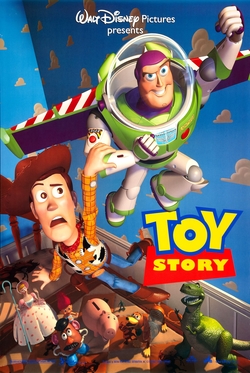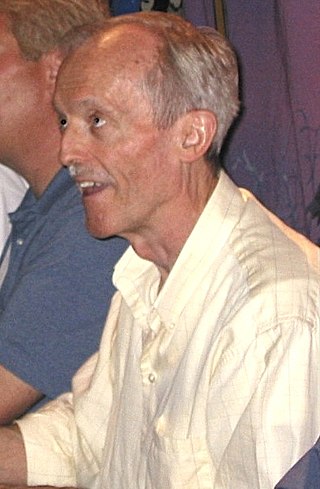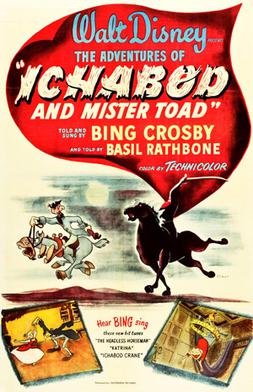
Animation is a method by which still figures are manipulated to appear as moving images. In traditional animation, images are drawn or painted by hand on transparent celluloid sheets to be photographed and exhibited on film. Today, many animations are made with computer-generated imagery (CGI). Computer animation can be very detailed 3D animation, while 2D computer animation can be used for stylistic reasons, low bandwidth, or faster real-time renderings. Other common animation methods apply a stop motion technique to two- and three-dimensional objects like paper cutouts, puppets, or clay figures.

Toy Story is a 1995 American computer-animated comedy film directed by John Lasseter, produced by Pixar Animation Studios and released by Walt Disney Pictures. The first installment in the Toy Story franchise, it was the first entirely computer-animated feature film, as well as the first feature film from Pixar. It was written by Joss Whedon, Andrew Stanton, Joel Cohen, and Alec Sokolow from a story by Lasseter, Stanton, Pete Docter, and Joe Ranft. The film features music by Randy Newman, was produced by Bonnie Arnold and Ralph Guggenheim, and was executive-produced by Steve Jobs and Edwin Catmull. The film features the voices of Tom Hanks, Tim Allen, Don Rickles, Jim Varney, Wallace Shawn, John Ratzenberger, Annie Potts, R. Lee Ermey, John Morris, Laurie Metcalf, and Erik von Detten.

A storyboard is a graphic organizer that consists of illustrations or images displayed in sequence for the purpose of pre-visualizing a motion picture, animation, motion graphic or interactive media sequence. The storyboarding process, in the form it is known today, was developed at Walt Disney Productions during the early 1930s, after several years of similar processes being in use at Walt Disney and other animation studios.
The golden age of American animation was a period in the history of U.S. animation that began with the popularization of sound cartoons in 1928 and gradually ended in the late 1960s, where theatrical animated shorts began losing popularity to the newer medium of television animation, produced on cheaper budgets and in a more limited animation style by companies such as Hanna-Barbera, UPA, Jay Ward Productions, and DePatie-Freleng.
Modern animation in the United States from the late 1980s to the late 1990s is referred to as the renaissance age of American animation. During this period, many large American entertainment companies reformed and reinvigorated their animation departments, following a dark age during the 1960s to mid 1980s. During this time the United States had a profound effect on animation worldwide.

An animator is an artist who creates multiple images, known as frames, which give an illusion of movement called animation when displayed in rapid sequence. Animators can work in a variety of fields including film, television, and video games. Animation is closely related to filmmaking and like filmmaking is extremely labor-intensive, which means that most significant works require the collaboration of several animators. The methods of creating the images or frames for an animation piece depend on the animators' artistic styles and their field.

The Emperor's New Groove is a 2000 American animated slapstick comedy film produced by Walt Disney Feature Animation and released by Walt Disney Pictures. The 40th animated film produced by the studio, it was directed by Mark Dindal and produced by Randy Fullmer, from a screenplay by David Reynolds, and a story by Dindal and Chris Williams. The voice cast features David Spade, John Goodman, Eartha Kitt, Patrick Warburton, and Wendie Malick. Inspired by ancient Peruvian culture and set in an Incan empire, The Emperor's New Groove follows young and self-centered Emperor Kuzco, who is accidentally transformed into a llama by his ex-advisor, Yzma (Kitt), and her dim-witted but affable henchman and sidekick, Kronk (Warburton). For the emperor to change back into a human, he entrusts a village leader, Pacha (Goodman), to escort him back to the palace before Yzma can track them down and finish him off.

Atlantis: The Lost Empire is a 2001 American animated science fiction adventure film produced by Walt Disney Feature Animation and released by Walt Disney Pictures. The 41st film produced by the studio, it was directed by Gary Trousdale and Kirk Wise and produced by Don Hahn from a screenplay by Tab Murphy. The film features an ensemble voice cast that includes Michael J. Fox, Cree Summer, James Garner, Leonard Nimoy, Don Novello, Phil Morris, Claudia Christian, Jacqueline Obradors, Jim Varney, Florence Stanley, John Mahoney, David Ogden Stiers and Corey Burton. Set in 1914, the film tells the story of young linguist Milo Thatch, who gains possession of a sacred book, which he believes will guide him and a crew of mercenaries to the lost city of Atlantis.

Traditional animation is an animation technique in which each frame is drawn by hand. The technique was the dominant form of animation in cinema until computer animation.

Donald Virgil Bluth is an American film director, animator, production designer, and animation instructor, best known for his animated films, including The Secret of NIMH (1982), An American Tail (1986), The Land Before Time (1988), All Dogs Go to Heaven (1989), Anastasia (1997), and Titan A.E. (2000), for his involvement in the LaserDisc game Dragon's Lair (1983), and for competing with former employer Walt Disney Productions during the years leading up to the films that became the Disney Renaissance. He is the older brother of illustrator Toby Bluth.

Chicken Little is a 2005 American computer-animated science fiction comedy film produced by Walt Disney Feature Animation and distributed by Buena Vista Pictures Distribution. The 46th animated film produced by the studio, it was directed by Mark Dindal from a screenplay by Steve Bencich, Ron J. Friedman, and Ron Anderson, based on a story by Dinal and Mark Kennedy, loosely inspired on the European folk tale "Henny Penny", known in the United States as "Chicken Little". In this version, the title character is ridiculed by his town for causing a panic, thinking that the sky was "falling". A year later he attempts to fix his reputation, followed by an unexpected truth regarding his past being revealed. The film is dedicated to Disney artist and writer Joe Grant, who died before the film's release. This also marked the final film appearance of Don Knotts during his lifetime, as his next and final film, Air Buddies, would be released posthumously.

Walt Disney Animation Studios (WDAS), sometimes shortened to Disney Animation, is an American animation studio that creates animated features and short films for The Walt Disney Company. The studio's current production logo features a scene from its first synchronized sound cartoon, Steamboat Willie (1928). Founded on October 16, 1923, by brothers Walt Disney and Roy O. Disney, it is the oldest-running animation studio in the world. It is currently organized as a division of Walt Disney Studios, a division of Disney Entertainment, and is headquartered at the Roy E. Disney Animation Building at the Walt Disney Studios lot in Burbank, California. Since its foundation, the studio has produced 61 feature films, from Snow White and the Seven Dwarfs (1937) to Strange World (2022), and hundreds of short films.

The Adventures of Ichabod and Mr. Toad is a 1949 American animated anthology film produced by Walt Disney Productions, released by RKO Radio Pictures and directed by Clyde Geronimi, Jack Kinney and James Algar with Ben Sharpsteen as production supervisor. The 11th animated film in the Disney Animation canon, it consists of two segments: the first based on the 1908 children's novel The Wind in the Willows by British author Kenneth Grahame, and the second based on the 1820 short story "The Legend of Sleepy Hollow" by American author Washington Irving.

Tarzan is a 1999 American animated adventure film produced by Walt Disney Feature Animation and released by Walt Disney Pictures. The 37th film produced by the studio, and the tenth and last released during the Disney Renaissance era, it is based on the 1912 story Tarzan of the Apes by Edgar Rice Burroughs, being the first animated major motion picture version of the story. The film was directed by Kevin Lima and Chris Buck and produced by Bonnie Arnold from a screenplay by Tab Murphy, Bob Tzudiker, and Noni White. The film stars the voices of Tony Goldwyn, Minnie Driver, Glenn Close, Rosie O'Donnell, Brian Blessed, Lance Henriksen, Wayne Knight, and Nigel Hawthorne.
Previsualization is the visualizing of scenes or sequences in a movie before filming. It is a concept used in other creative arts, including animation, performing arts, video game design, and still photography. Previsualization typically describes techniques like storyboarding, which uses hand-drawn or digitally-assisted sketches to plan or conceptualize movie scenes.
Douglas Wood is an author, writer, actor, creative executive, director and producer. He has been a VP of Animation Development and Production for Steven Spielberg at Amblin Entertainment, Turner Pictures, Warner Bros. and Universal.
Darrell Rooney is a Canadian animator, storyboard artist, and director for The Walt Disney Company, best known for directing The Lion King II: Simba's Pride (1998) and Mulan II (2004) at Disneytoon Studios. He started at Disney in 1978, and worked as a visual effects animator on Tron (1982).

The Thief and the Cobbler is an unfinished animated fantasy film co-written and directed by Richard Williams. Originally conceived in the 1960s, the film was in and out of production for nearly three decades due to independent funding and ambitiously complex animation. It was finally placed into full production in 1989, when Warner Bros. agreed to finance and distribute the film. When production went over budget and behind schedule, it was heavily cut and hastily re-edited by producer Fred Calvert without Williams's involvement. It was eventually released by Allied Filmmakers in 1993 with the title The Princess and the Cobbler. Two years later, Miramax Films, which was owned by Disney at the time, released another re-edit titled Arabian Knight. Both versions of the film performed poorly at the box office and received mixed reviews.
Zahra Dowlatabadi is an Iranian-born American filmmaker and film producer.
Alessandro Carloni is an Italian film director, animator, and art director, best known for his work with DreamWorks Animation in general, particularly the Kung Fu Panda films. He co-directed Kung Fu Panda 3, alongside Jennifer Yuh Nelson.












